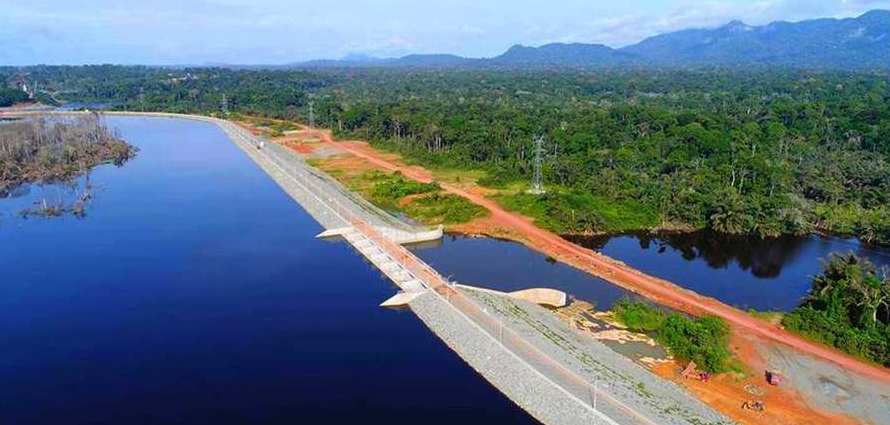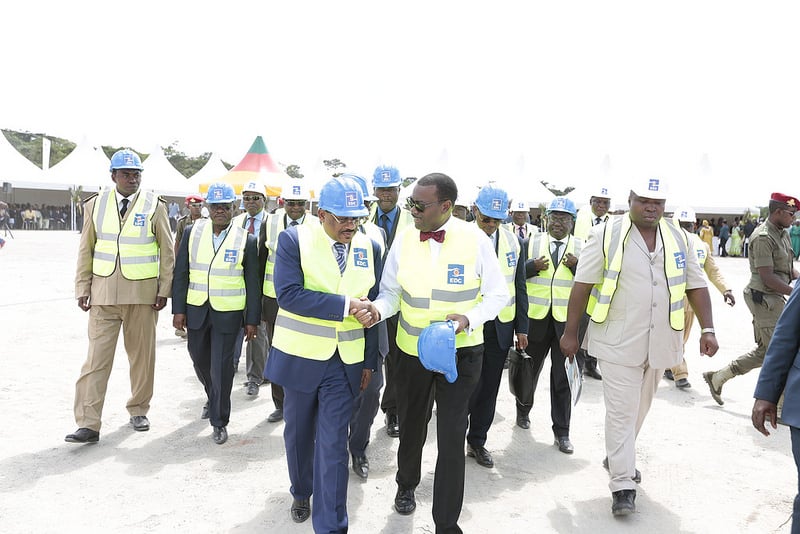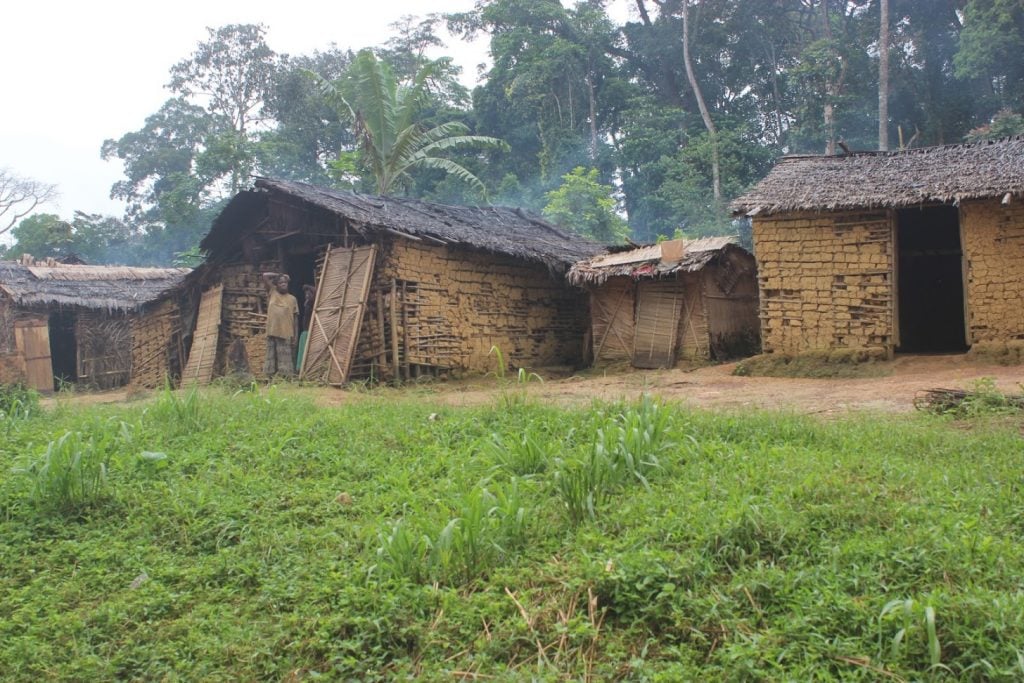Sitting in front of his mud house in Pangar village, one of the forest communities in the East region, Mokuine Anatole, a 45 years old farmer and hunter, is busy sharpening his machete in readiness for the days farming and hunting expedition that carries him some 25 km away from home.

Environment critics say it is environmentally unwise to concentrate a series of dams along the Sanaga river.
It’s 8 a.m, and the early morning sunrise so visible heralding a bright working day. But some two kilometers from his village, there are signs of trouble. The natural fresh air has been polluted by the smell of gasoline wafting through the vicinity as the silence of the surrounding forest gives way to the hooting and rumbling from cars and bulldozer machines at work, opening up rich forest along the confluence of the Lom and Pangar rivers. Here, the government has begun the second phase of the construction of the LomPangar hydro-dam.
“This hydro-dam project has made life perilous for us,” Mokuine Anatole told InfoCongo.
“The first phase of the project has brought human encroachment, destroyed our forest land and scaring away all the animals. We are obliged to go farming and hunting in far distances where we can find something to eat,” he said.
“And now they have started another phase, aggravating an already bad situation,” he lamented, shaking his head in disapproval.

Well managed, Cameroon’s energy potential can add value to the resources and livelihood of the surrounding population but also accelerate the desired regional integration in the CEMAC zone, says the President of the African Development Bank, Dr. Akinwumi Adesina
The Cameroon authorities are touting the construction of multiple dams along the Sanaga River, the primary water source in the country which already has the Edea and Song Loulou dams downstream to intensifying hydro-electricity drive as part of its ambitious plans to become an emerging economy by 2035.
“These dams are expected to improve Cameroon’s energy by 2024 substantially,” says Louis Paul Motaze, Minister of the Economy, Planning, and Regional Development.
Cameroon, whose economy was forecast to grow by at least 5 percent annually between 2015 and 2018, says it is undertaking these hydro dam electricity projects to ramp up power production to 3 000 Megawatts (MW) by 2030, up from 1 200MW in 2017.
Unfortunately, the hidden cost of these projects seem to be going unnoticed with very little regards to their impacts on the livelihood of the indigenous forest communities along the banks of the river Sanaga, experts say.
But with over four additional hydro-dam projects slated for completion by 2024, along with the river basin surrounded by gorgeous forest, compromising the health risk, biodiversity, the survival of indigenous communities which rely on them, environment experts say this would be a disaster.
“If all these projects take place, you would have a good chunk of the forest and wildlife in the Congo Basin disappearing,” says Epanda Manfred, African Wildlife Foundation coordinator in Cameroon.

The African Development Bank which has already invested FCFA 35 billion for the project and on July 17, 2017, provided another 150 million dollars to support the building of yet another hydro-dam at the Nachtigall Falls.
The projects, he says, are a significant threat to the protected Deng Deng forest area in the East region as well as the survival of the forest communities that rely on them.
At Deng Deng, village, Gregore Nvogo, a farmer just returning from his farm, vents out his anger on the news of the construction of more dams along the river Sanaga.
“The construction of another dam here means we will continue to lose our forest, our land, and our fishing opportunities.”
“The Lom Pangar dam has virtually submerged our forest and land for agriculture, pushing us to cultivate in far distances. We no longer find animals. We cannot do fishing around the village. Where do we go now?” he asked.
The worries of the farmers above highlight the growing anger among forest communities at big development projects which displace villagers, leading to hardship and sometimes conflicts.
Clashes pitting forest communities against government’s keen to develop infrastructure in forest areas are likely to become more common in Cameroon as demand for land surges, experts say.
“We have observed a surge in investment activities in forest areas with the increased presence of Chinese and other foreign business operators in Cameroon, and this is disturbing because the rights of these forest communities are constantly violated leading to clashes, says Benard Njonga, coordinator of a Cameroon-based nongovernmental organization.
Health experts say the building of such multiple dams come along with some health risk.
“Severe health problems often result from the filling of the reservoir that holds the water for powering the project’s electric generators. Dams usually create vast pools of standing water that serve as breeding ground for disease-carrying insects like mosquitoes spreading malaria and river blindness,“ says Dr. Isaac Ngide of the Muyuka District Hospital.
Local community authorities also say there is trouble with increasing forest oversight and violation of their rights by the investors.
“Forest that used to serve as an important safety net for the poor rural community is no longer under our control,” says Paul Gbalene, Traditional Chief of Djoameodjoh, one of the forest communities in the East affected by the dam projects.
Government and development partners, however, assure all the rights of the affected communities in the hydro dam projects would be met.
“We are conscious of the socio-economic and environmental responsibilities. The government is doing everything to address these,” assured Louis Paul Motaze at the launch of the construction works of the 30 MW power generation plant in Lom-Pangar in Belabo sub-division of the East Region on July 16, 2017.
The President of the African Development Bank, Dr. Akinwumi Adesina said Cameroon has considerable energy potential. Well managed, he said, it will not only add value to the resources and livelihood of the surrounding population but also accelerate the desired much regional integration in the CEMAC zone.

“The first phase of the project has brought human encroachment, destroyed our forest land and scared away all the animals. We are obliged to go farming and hunting in far distances where we can find something to eat,” says Mokuine Anatole, a resident of one of the communities affected by the dam projects
Dr. Adesina pledged AfDB’s support to light up Cameroon and Africa at large.
“AfDB will be involved in all energy projects in Cameroon, a drive geared at connecting 500,000 households in 2017,” he said.
Adesina further disclosed that the bank would invest some 12 billion dollars in electricity projects for the next five years in Africa where some 645 million people do not have access to electricity.
The power generation plant in Lom Pangar according to the General Manager of Electricity Development Corporation, Theodore Nsangou will allow the electrification of some 150 localities covering about 20,000 households with an estimated beneficiary population of 150,000.
The China CAMC Engineering company is the constructing firm with funding from the African Development Bank which has already invested FCFA 35 billion for the project and on July 17, 2017, provided another 150 million dollars to support the building of yet another hydro-dam at the Nactigal Falls.
The Nachtigall Dam to be constructed on the Sanaga River 65km from the capital, Yaounde government says, will produce 420 MW of electricity, enough to satisfy a third of Cameroon’s energy needs.
However, environment critics say it is environmentally unwise to concentrate a series of dams along the Sanaga river.
Augustine Njamnshi of the Cameroon chapter of Pan African Climate Justice Alliance (PACJA) has challenged the wisdom of constructing other dams along the Sanaga River, adding to the existing ones downstream like the 263MW Edea and 396MW Song Loulou dams that currently provides 95 percent of Cameroon’s electricity production.
He says this will make Cameroon heavily dependent on hydroelectric power, putting the country at great risk of economic break down whenever droughts hit the river basin in the future.
“This will be tantamount to an economic suicide plunge,” Njamnshi noted.
“With the abundance of sunlight, Cameroon needs just the political will to turn its energy deficiency into energy surplus accessible not only to the remote parts of the country but also to neighboring countries in the CEMAC region,” he says.
